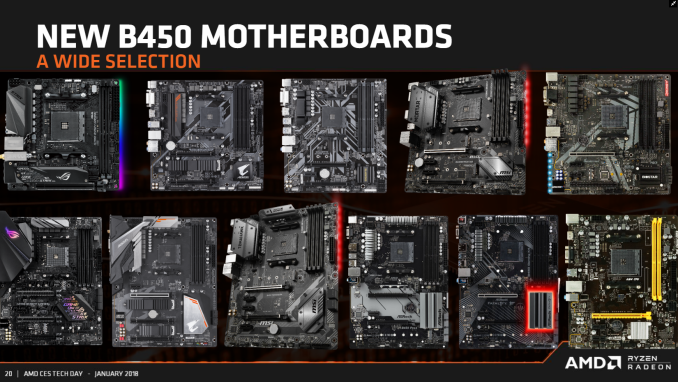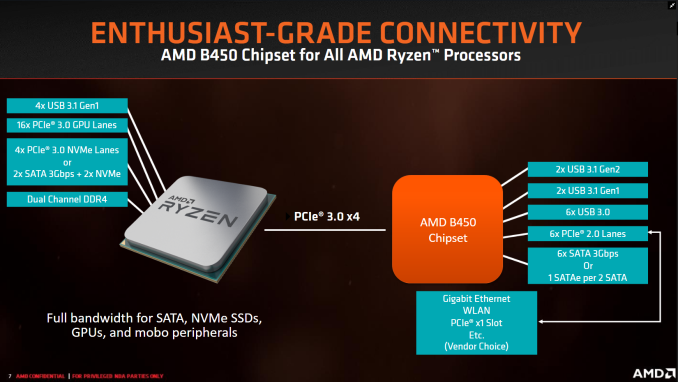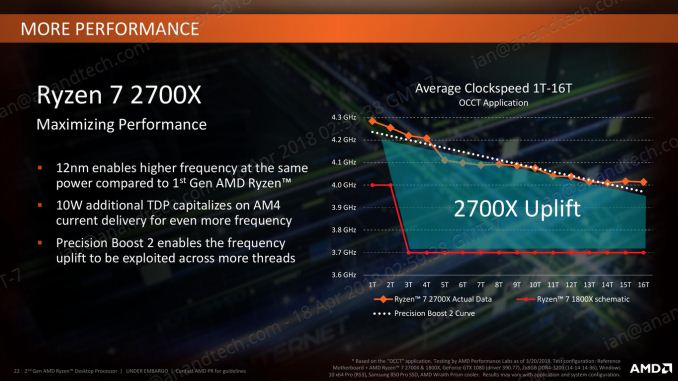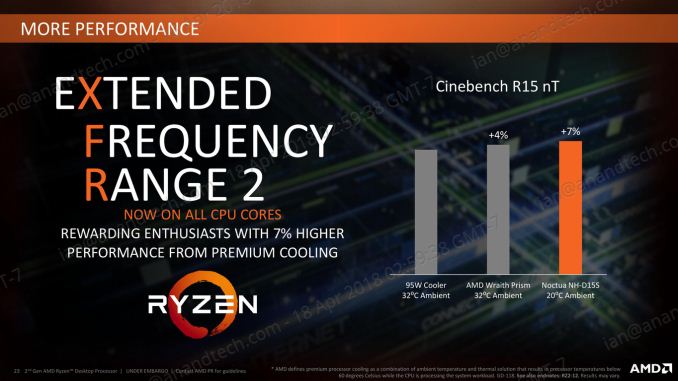Analyzing B450 for AMD Ryzen: A Quick Look at 25+ Motherboards
by Gavin Bonshor on July 31, 2018 8:00 AM EST
One of the secondary stories from Computex was that AMD and its partners were set to launch a new generation of mid-range chipsets and motherboards with the new lower-power version of the chipset. The B450 chipset is the direct successor to B350, with lower power and features such as Precision Boost 2, XFR2, and StoreMI support. The planned release of 25+ motherboards models is sure to add variety to the market and we take a quick look at all the boards ahead of the launch from vendors such as MSI, ASRock, ASUS, and GIGABYTE.
What's New with the B450 Chipset?
The new B450 chipset launch compliments the release of the Ryzen 2000 series processors, with AMD looking at its current mid-range and high-end parts. The B450 chipset is designed to be a cheaper entry point into the ecosystem, even for users picking up the eight-core Ryzen 2700X ($329) and hex-core Ryzen 2600X ($229) units and going to overclock.
Like the already released X470 Promontory chipset, the B450 chipset is the direct successor to previous first generation B350 chipset. Not much hasn’t changed on the surface in regards to USB connectivity, storage options and PCI lanes, however AMD has added a couple of new technologies to bolster the appeal of the new budget-focused chipset.
| AMD AM4 Chipsets | |||||||||||||
| DDR4 | OC | USB | SATA | PCIe 2.0 |
GPU | XFR2 PB2 |
StoreMI | TDP | RAID SATA |
RAID NVMe |
|||
| 3.1 | 3.0 | 2.0 | |||||||||||
| X470 | 2933 | Y | 2 | 6 | 6 | 6 | 8 | x8/x8 | Y | Y | 4.8W | 0,1,10 | |
| X370 | 2667 | Y | 2 | 6 | 6 | 6 | 8 | x8/x8 | N** | N^ | 6.8W | 0,1,10 | |
| B450 | 2667+ | Y | 2 | 2 | 6 | 6* | 6 | x16 | Y | Y | 4.8W | 0,1,10 | |
| B350 | 2667 | Y | 2 | 2 | 6 | 4 | 6 | x16 | N** | N^ | 6.8W | 0,1,10 | |
| A320 | 2667 | N | 1 | 2 | 6 | 4 | 4 | x16 | N** | N^ | 6.8W | 0,1,10 | - |
| Embedded | |||||||||||||
| X300 | 2667 | Y | 0 | 4 | 0 | 2 | 4 | x8/x8 | N | N | ? | 0,1 | - |
| B300 | 2667 | N | 0 | 4 | 0 | 2 | 4 | x16 | N | N | ? | 0,1 | - |
| A300 | 2667 | N | 0 | 4 | 0 | 2 | 4 | x16 | N | N | ? | 0,1 | - |
*possibly four, double checking with AMD
**Can be possible with BIOS updates, will be motherboard dependant
^ Can be enabled with certain CPUs if a license is purchased
While the specifications on the surface make the B450 seem like a carbon copy of the B350 chipset, as they share native support for the same USB configuration, the same SATA configuration, support for a single M.2 PCIe 3.0 x4/SATA port, and six PCI lanes dedicated to PCIe 2.0 slots. They also both enable support for the same PCIe 3.0 bifurcation, giving a single PCIe 3.0 x16 slot, focusing these systems on a single GPU.
Lower Power and StoreMI For Everyone (on B450 and X470)
As with the jump from the X370 to the X470 chipsets, a primary difference from B350 to B450 come through lower power consumption - the B450 chipset runs a lower powered integrated controller which reduces the idle power draw by just under 2 W, from 6.8 W to 4.8 W.
Another big feature is AMD's StoreMI storage technology which isn’t necessarily an addition to the chipset itself, but enabled through B450. This enables users to unify the various storage in their system to make the best arrangement for the fastest access to data. The StoreMI technology is explained further in our Ryzen 2700X, 2700, 2600X and 2600 processor reviews.
Precision Boost 2: No More Turbo Tables
One of the biggest changes, related to the Ryzen-2000 series, is in how the processor implements its turbo. Up until this point (except the recent APU launch), processors have relied on a step function implementation: the system determines how many threads are loaded, attempts to implement a specific frequency on those cores if possible, and then follows the look-up table relating thread count to frequency. AMD’s goal in Precision Boost 2 is to make this process more dynamic.
This image from AMD is how the feature is being represented: the system will determine how much of the power budget is still available, and turbo as much as possible until it hits one of the limiting factors. These factors can be any of, but not limited to, the following:
- Total chip peak power
- Individual core voltage/frequency response
- Thermal interactions between neighboring cores
- Power delivery limitations to individual cores/groups of cores
- Overall thermal performance
Extended Frequency Range 2 (XFR2): Cooler = Faster, Right?
The following analysis on XFR2 comes from our previous AMD Ryzen 2700X, 2700, 2600X and 2600 review.
For the Ryzen 2000-series, AMD has changed what XFR does. In the previous generation, it was applied on certain processors to allow them to boost above the maximum turbo frequency when the thermal situation was conducive to higher frequencies and higher voltage in low thread-count states. For this generation, it still relates to thermals, however the definition is applied to any core loading: if the CPU is under 60ºC, the processor can boost no matter what the loading is above its Precision Boost 2 frequency (so why not get a better PB2 implementation?). The core still has to be within a suitable voltage/frequency window to retain stability, however.
Both Precision Boost 2 and Extended Frequency Range 2 are supported on B450.
Other AnandTech Ryzen Coverage
- The AMD 2nd Gen Ryzen Deep Dive: 2700X, 2700, 2600X, and 2600 Tested
- The AMD Ryzen 5 2400G and Ryzen 3 2200G APU Review: Marrying Vega and Zen
- The AMD Ryzen 3 1300X and Ryzen 3 1200 CPU Review: Zen on a Budget
- The AMD Ryzen 5 Review: All Ryzen 5 CPUs Tested
- The AMD Zen and Ryzen 7 Review: A Deep Dive on 1800X, 1700X and 1700
- Overclocking The AMD Ryzen APUs: Guide and Results
- Delidding The AMD Ryzen APUs: How To Guide and Results
- Best CPUs for Gaming: Q2 2018
Motherboards in This Overview
- ASRock B450 Gaming K4
- ASRock B450 Gaming ITX/ac
- ASRock B450 Pro4
- ASRock B450M Pro4
- ASRock B450M-HDV
- ASUS Strix B450-F Gaming
- ASUS Strix B450-I Gaming
- ASUS TUF B450-Plus Gaming
- ASUS TUF B450M-Plus Gaming
- ASUS Prime B450-Plus
- ASUS Prime B450M-K
- GIGABYTE B450 Aorus M
- GIGABYTE B450 Aorus Elite
- GIGABYTE B450 Aorus Pro
- GIGABYTE B450 Aorus Pro WiFi
- GIGABYTE B450M DS3H
- MSI B450 Gaming Plus
- MSI B450M Gaming Plus
- MSI B450 Gaming Pro Carbon AC
- MSI B450I Gaming Plus AC
- MSI B450 Tomahawk
- MSI B450M Bazooka
- MSI B450M Bazooka Plus
- MSI B450M Mortar
- MSI B450M Mortar Titanium
- MSI B450-A Pro
- MSI B450M Pro-M2
- MSI B450M Pro-VDH
- Choosing the Right B450 Motherboard















62 Comments
View All Comments
theanalyzer - Tuesday, July 31, 2018 - link
Signed up to point that out. Needs to be fixed. It’s the only ITX board supporting 2x which sets it’s apart form the competitionDeath666Angel - Tuesday, July 31, 2018 - link
Glad to see more options in the mATX range with two M.2 slots, not just from AsRock this time around. My next rig will either be based on the AsRock B450M Pro4 or one of the MSI B450M Mortar boards. Will wait for actual VRM setup and overclocking results / general tests to see which one will be it. I had motherboards from both manufacturers and was pleased with both. MSI has the advantage of offering PCIe M.2 options for both slots as well as SATA. One question regarding that: if I install a 3.0 PCIe x2 M.2 SSD into a 2.0 PCIe x4 slot, what will be the speed ramifications? Can it only use 2.0 PCIe x2 or can it use the full x4, thus being similar in speed to a native 3.0 PCIe x2 setup? :) Still waiting on mATX x470 mainboards.Outlander_04 - Tuesday, July 31, 2018 - link
.3.0 x 2 is the same speed as 2.0 x 4DanNeely - Tuesday, July 31, 2018 - link
Except that a 3.0 x2 drive is almost certainly x2 because it only has 2 PCIe lanes (cutting down on them is one of the ways the cheaper drives pinch pennies), which means it will be connected at 2.0 x2; at that point you might as well just use a SATA drive and save a bit more money.Death666Angel - Tuesday, July 31, 2018 - link
Thanks for providing an answer to my actual question. :)AdrianB1 - Tuesday, July 31, 2018 - link
You will get a 2 lane PCIe 2.0 connection, that means 1 GB/s. This is 1/4 of a PCIe 3.0 4-lane usual NVME drive, but real life you may get closer to 80% of the performance.Death666Angel - Tuesday, July 31, 2018 - link
Thanks!Outlander_04 - Tuesday, July 31, 2018 - link
Finally some budget boards with solid VRMs.skpetic - Tuesday, July 31, 2018 - link
There are some seriously shady stuff going on with VRMS om X470 og B450. Check out Buildzoid on youtube. Asus B450 STRIX ITX board is single phase for SoC. Several of the Gigabyte B450 and X470 boards in reality have half the advertised amount of phases or are using doublers:https://www.youtube.com/watch?v=3IjWCOXSuKU
meacupla - Tuesday, July 31, 2018 - link
hahaha... noAsus with the absolute trash tier VRM heatsinks
AsRock with fake phases
Gigabyte with fake phases and trash VRM heatsinks
MSI with no Vcore offset